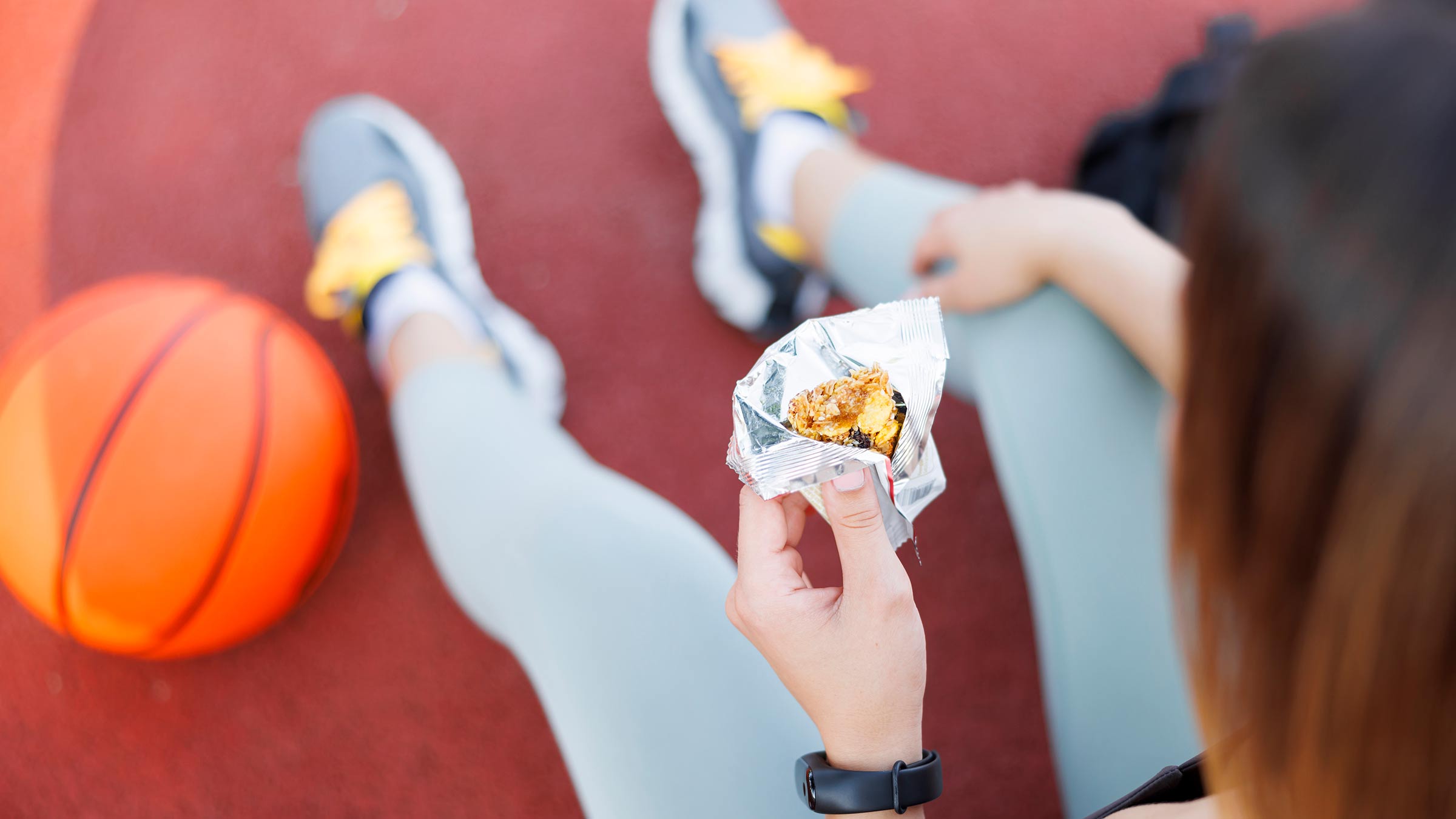
Many parents know that sending young athletes off to school with a simple brown bag lunch will no longer cut it. With schedules that include early-morning workout sessions, after-school practices and evening competitions, students may need portable food options to fuel them from sun-up to sundown.
But it’s not easy to wade through the many choices staring you down from the grocery store shelves. You may worry, “Are my children getting enough protein? Are snack bars nutritious? Do their favorite drinks have too much sugar?”
But there’s no need to be overly concerned. If you focus on a few things, your children will have the strength, energy and brain power they need to power through those long days.
Provide frequent snacks and meals for young athletes
For starters, try to provide enough meals and snacks so that young athletes can eat every two to three hours.
Children, teenagers and younger adults are still growing, and they need to eat regularly to support that development. They also burn calories quickly but can’t consume as many in one sitting as adults.
It’s important for brain, muscle and bone health that the blood sugar remains level and young athletes should never be running on empty. Eating smaller amounts of food more often will help sustain those levels.
Focus on “macronutrients” in young athletes’ snacks
Every snack and meal should have carbohydrates, proteins and fats. Don’t get overly focused on ratios, but shoot for roughly 60% carbohydrates, 20% proteins and 20% fats.
Protein for muscle tissue
We break down muscle tissue every time we move, from getting out of a chair to running across a soccer field or jumping on a basketball court. Protein provides amino acids as the building blocks to help restore that tissue.
But our bodies can only use so much protein at one time, and smaller bodies can use even less at one time, so it’s important to spread out protein sources through the day.
These sources include chicken, fish and red meat, but also the more-packable cheese, peanut butter, yogurt, seeds and nuts.
Carbohydrates for energy
Carbohydrates are extremely important, ensuring student athletes have energy to burn so it isn’t pulled from other places, like muscle or fatty acids. Think colorful fruits and vegetables that include antioxidants and anti-inflammatories, but also whole grains, like whole grain bread, whole grain cereals or quinoa.
Fat for brain and hormone health
Healthy fats support brain health and hormones. Fats also help young people feel fuller faster and provide needed calories for growth and development, containing 9 calories per gram, compared with 4 calories per gram in carbohydrates and proteins. Stick with healthy monounsaturated and polyunsaturated fats, such as those found in avocados, seeds, nuts and fish.
Ensure young athletes stay hydrated
Dehydration is the biggest hindrance to performance and leads to a high risk of injury. It also helps with blood flow to the brain, allowing athletes to focus. I tell athletes to look at their urine at night. If it’s not clear or a light lemonade color, they're dehydrated. It may be neon tinted if they’re using a vitamin supplement, but it should still be clear.
Athletes should drink what they love, as long as they stay away from caffeine — especially highly caffeinated beverages, which can negatively impact the heart and central nervous system. Orange juice or other fruit juices, flavored water and sports drinks are all good options for replenishing lost water.
Choose simple, carbohydrate-rich snack bars for young athletes
When choosing snack bars, there are a few things to consider.
- The ratio of carbohydrate-to-protein should be two-to-one or three-to-one to ensure adequate energy.
- Look for as few ingredients as possible, ideally four or five ingredients.
- Look for ingredients you recognize, such as nuts or dried fruits, over those you can’t pronounce.
Don’t be overly concerned about sugar and salt for student athletes
Sugar
Sugar is not the enemy we think it is when it comes to student athletes participating in long, intense practices. Sugars, such as those found in sports drinks made from fruit juices, for example, are the easiest way for young athletes to replace the glycogen energy they’re using up. Without a replacement for those carbohydrates, students are at risk of injury and weakening their immune systems, so that immediate fuel has its place.
It’s also important to note that the type of sugar you choose matters. Sugar from fruits or whole grain breads, for example, comes with a dose of fiber and nutrients, while sugar from white bread or processed foods, like cookies and cakes, is stripped of those benefits.
Salt
Salt is important for hydration in young athletes. They sweat heavily due to the added activity, and salt helps them absorb fluid. Allow them to snack on pretzels or crackers, and don’t be too concerned if they use a touch of table salt on food.
Remember: Nutrition is important for injury prevention
When athletes are running on empty, the brain struggles to stay focused, memory isn’t as sharp, and mistakes can lead to injuries. Sound nutrition also provides the micronutrients that prevent injury. For example, calcium and vitamin D reduce the likelihood of broken bones and stress fractures.
Create your own healthy snacks for student athletes
You don’t always have to rely on prepackaged foods to power athletes through long days. An example of an easy snack would be an orange, string cheese and a handful of nuts. A simple peanut butter and jelly sandwich on whole grain bread would also fit the bill: Combining a whole grain with a bean or a legume (like peanuts) results in a complete protein, and PB&J also gives us lots of good carbohydrates and fats.
Homemade trail mix
Student athletes can have a hand in making trail mix. Have them pick a favorite (lower sugar) cereal, some dried fruit like cherries or cranberries, pretzels or snack crackers, chocolate chips or candies and nuts or seeds.
No-bake energy bites
Combine carbohydrate- protein- and fat-packed ingredients and roll into bite-sized balls. Try the following combinations from the Ohio State Wexner Medical Center Sports Nutrition. Each recipe makes about a dozen bites, which you’ll want to wrap in wax paper before packing.
Chocolate version:
- 2 ½ cups old-fashioned rolled oats
- ⅓ cup cocoa powder
- ¼ cup mini chocolate chips
- ¼ cup unsweetened shredded coconut
- ½ cup creamy peanut butter
- ½ cup honey
- ¼ teaspoon kosher salt
- ¼ teaspoon ground cinnamon
Monster cookie version:
- 2 ½ cups old-fashioned or rolled quick oats
- 1 cup peanut butter
- ½ cup honey
- 1 teaspoon vanilla
- ½ cup mini candy-coated chocolate pieces
- ½ cup mini chocolate chips
White chocolate cranberry version:
- ¾ cup old-fashioned oats
- ⅓ cup shredded coconut
- ½ cup peanut butter
- ¼ cup white chocolate chips
- ½ cup dried cranberries
- 2 tablespoons maple syrup
- ¼ teaspoon salt
- ¼ teaspoon ground cinnamon
Pumpkin chocolate chip version:
- 2 ¼ cups old-fashioned or rolled quick oats
- ½ teaspoon fine sea salt
- 1 teaspoon pumpkin spice
- ½ cup pumpkin puree
- ¼ cup peanut butter
- ¼ cup maple syrup
- ⅓ cup chocolate chips

Ready to be at the top of your game?
Ohio State’s sports medicine experts are here to keep you in your game, maximize your performance and keep you healthy.
Learn more




